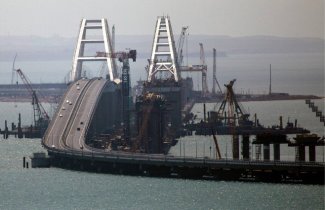A closely watched basin. The Russian–Ukrainian tensions in the Sea of Azov

The construction and opening in May 2018 of the Crimean Bridge, which connects the territory of the Russian Federation with the Russian-annexed Crimean Peninsula, has contributed to a worsening of Russian–Ukrainian relations in the Sea of Azov. Since April 2018, Russians have halted merchant ships sailing through the Strait of Kerch, which is greatly limiting the operation of Ukrainian ports in the Sea of Azov. Russia’s actions are affecting Ukraine’s economy in that they make the export of goods that account for a major portion of Ukraine’s state budget revenue increasingly difficult. According to estimates by the Ukrainian Ministry of Infrastructure, total financial losses due to shipping limitations stand at US$ 20–40 million annually.
Russia’s activity in the Sea of Azov and in the Strait of Kerch seems to confirm Moscow’s ambitions to make this basin a fully Russian-controlled internal area. Increased concentration of the Russian armed forces near the Crimean Bridge proves that this piece of infrastructure is of strategic importance for the Russian Federation. Access to the Sea of Azov and control of the ships sailing through the Strait of Kerch enables Russia to exert economic blackmail on Ukraine. The measures Russia has launched are of a permanent nature and are also intended to exacerbate Ukraine’s difficult economic situation. In this way, the Russian leadership is trying to influence the public mood in the southern part of the Donbas (which is controlled by Kyiv) to persuade the local residents that any further confrontation with Russia would be senseless.
Detailed checks by the Border Service of the FSB
The rising tension between Russia and Ukraine in the Sea of Azov and in the Strait of Kerch is yet another phase of the Russian–Ukrainian conflict that followed the annexation of the Crimean Peninsula by Russia. In late March 2018, Ukrainian border guards halted the “Nord” fishing cutter that sailed under the Russian flag. Members of its crew were arrested and sentenced for crossing the border illegally. Russia used this incident as a pretext to accuse Ukraine of using ‘state-sponsored piracy’[1]. According to Russia, Ukraine had no right to halt the vessel because an agreement is in force regarding cooperation in using the Sea of Azov and the Strait of Kerch. It was signed in 2003 and ratified by parliaments of the two countries in April 2004. The agreement stipulates that the basin should be considered as an internal sea of both states and that Ukrainian and Russian merchant ships and warships should be free to sail there[2]. The agreement also contained an announcement that a border will be delimited both in the Sea of Azov and in the Strait of Kerch. However, negotiations regarding this issue, which have been ongoing since 2003, have brought no result because of Russia blocking this process.
In its reaction to the arrest of the Russian fishing cutter, Russia threatened to block the movement of Ukrainian vessels through the Strait of Kerch, which would considerably disrupt the operation of commercial sea ports in Berdiansk, Mariupol and Henichesk. This plan was put into practice in late April 2018, when the maritime border service of the FSB began to halt and thoroughly inspect merchant ships sailing to and from Ukrainian sea ports. Some of the ships were halted for more than 24 hours and some were targeted repeatedly. The Russian officials justified these measures through security reasons connected with terrorist threats. Russia intensified its actions in mid-May 2018, when military exercises were announced. Under the exercises carried out in the Sea of Azov, an area of around 2000 sq. kilometres comprising Ukrainian territorial waters near the port in Berdiansk, as well as other maritime areas, was fully closed for shipping. Inspections performed by Russian services continue, even though the exercises have officially ceased.
The inspections that have now been ongoing for three months resulted in the halting of around 150 ships owned by both Ukrainian and foreign companies operating in Ukrainian sea ports. Losses the carriers suffered as a result of Russia’s actions are estimated at US$ 5000–15000 daily, depending on the size of the ship and the duration of the inspection. As a consequence, some ship owners have withdrawn from cooperation with Ukrainian ports in the Sea of Azov and decided to redirect their vessels to Black Sea ports. The FSB’s actions are also causing direct financial losses for Ukrainian sea ports that have been forced to suspend their operations. The drop in commercial traffic caused the sea port in Mariupol to fully suspend its operations for several days in early June. In response to Russia’s actions, Ukraine announced its plan to carry out military exercises along the Ukrainian coast of the Sea of Azov between 1 June and 1 September 2018. In this way, the Ukrainian side is trying to prevent the border service of the FSB from coming anywhere near the Ukrainian sea ports and continuing to halt merchant ships operating there.
The bridge of special importance
The bridge over the Strait of Kerch is another important problem for the operation of Ukrainian ports in the Sea of Azov. Its construction and later the opening of its road traffic section in May 2018 considerably disrupted the movement of merchant ships. The assembly of the bridge’s arches in August and September 2017 halted the movement of all vessels through the strait, which – according to Ukraine – exposed the country to losses of around US$ 190 million[3].
Moreover, in contrast to Russia’s initial statements, the construction of the facility has caused a limitation of the size of vessels allowed to sail through the strait. At present, vessels measuring more than 33 metres in height and 160 metres in length are excluded from sailing through the strait. In this way, Panamax type ocean-going ships have been prevented from sailing there, which translated into financial losses suffered by the Ukrainian industrial sector. According to data compiled by the administration of the Mariupol sea port, in 2016 Panamax type ships accounted for 23% of all types of ships (144 vessels) that used this port and generated 43% of the volume of commodities transported in this port in that year. The necessity of renting several smaller ships instead of one larger ship has raised the cost of transportation, thereby reducing the attractiveness of Ukrainian ports and of their exports (due to a hike in the price of insurance of ships and their cargo, caused by the risk arising from operating in an unstable region threatened by military action). It should be noted that these limitations are of no particular importance for the operation of Russian ports located in the eastern part of the Sea of Azov. The average water depth in this part of the basin is 5 metres, which generates natural limitations for vessels operating there. The water depth in the ports of Berdiansk and Mariupol, on the other hand, is more than 8 metres, which enables ships with a much greater tonnage to use these ports.
The Mariupol sea port administration estimates that the limitations connected with the bridge construction have caused the trade in products of the metallurgy sector alone to shrink by 1.5 million tons annually, which translates into losses of around US$ 9.5 million. This has forced the metallurgical plants of the Metinvest Group, which is owned by oligarch Rinat Akhmetov, to switch to transporting goods by rail to Black Sea ports in Mykolaiv and Odesa to be able to process international orders. The turnover recorded by the Berdiansk sea port, for its part, shrank by 37% in 2017, which generated losses in many sectors of the local economy that depend on maritime transportation. According to estimates by Ukraine’s Ministry of Infrastructure, the total financial losses caused by shipping restrictions in the Strait of Kerch stand at around US$ 20 million annually, whereas indirect losses (for example, those connected with sea port employees losing their jobs) stand at US$ 40 million annually. Despite the fact that Ukrainian ports in the Sea of Azov recorded a 50% drop in the volume of shipped goods (from 17 663 million tons in 2013 to 8912 million tons in 2017[4]), which was due to the conflict in the eastern part of the country, revenue generated by this sector of the economy continues to be an important contribution to Ukraine’s state budget[5].
Apart from losing control of the Strait of Kerch, Ukraine was also stripped of its ability to collect so-called pilot fees and transit fees for the passage of merchant ships and warships. The resulting losses are estimated at several million US dollars annually. Back in May 2017, Kyiv brought a case against Russia to the Permanent Court of Arbitration in The Hague concerning the Russian Federation’s violation of the Ukrainian state’s right to use the resources located in the territorial waters in the Sea of Azov, the Black Sea and the Strait of Kerch. The case concerns depriving Ukraine of the possibility to use coastal infrastructure and sea reserves and at the same time illicit usage thereof by Russia. The accusation points to the illegal activity of Russian business entities in territories which belong to the Ukrainian state, including the construction of a bridge in the Strait of Kerch[6].
Extraordinary security measures
The bridge connecting the Crimean Peninsula and the continental part of the Russian Federation has been covered by extraordinary security measures, which confirms its strategic importance. A special task force composed of representatives of various ministries is working on ways to guarantee security of road and rail transportation, as well as the electricity network and the gas pipeline running through the Strait of Kerch. The team is trying to devise a comprehensive security system to include measures to counteract terrorist attacks from land, sea and air. For example, to protect the bridge a new system called “Penguin” is planned to be used, involving underwater drones capable of detecting divers and explosives, as well as a hydrolocation system emitting underwater acoustic impulses to deter individuals from approaching the bridge. Russians cite the terrorist threat posed by Ukrainian saboteurs as the reason behind this large-scale and costly investment in the protection of the infrastructure in the Strait of Kerch.
Providing immediate security to the bridge will be the task of the marine brigade of the Federal Service for the National Guard Troops of the Russian Federation, which is ultimately to be stationed near the newly-built bridge. This unit is to be equipped with four type 21980 Grachonok patrol boats intended for anti-sabotage and counter-terrorist activities. The brigade personnel will include specially-trained divers capable of protecting facilities of strategic importance. The newly-formed unit will also be given special powers to ensure shipping security near the bridge. To this effect, in mid-May in the first reading Russian State Duma adopted a government-prepared bill authorising the National Guard to halt ships, haul them away to Russian ports and arrest members of their crew[7].
Pressure as a tool to exert influence
In its actions, the Russian side mainly intends to target Ukraine’s economic interests. In late May 2018, units of the FSB’s border guard operating in the region, which form a portion of the Black Sea coast guard[8], were joined by three armoured artillery cutters[9]. However, in contrast to the opinions of some Ukrainian journalists and politicians, this should not be viewed as a harbinger of Russian military aggression[10]. These units are intended to operate in internal waters and will most likely be used as support by the FSB’s border guard that carries out intervention and pursuit activities. This may suggest that Russia is willing to demonstrate its readiness to launch decisive measures should the conflict in the region escalate. Due to military weakness of Ukraine’s naval forces on the one hand[11], and the operational potential of the Russian Black Sea Fleet on the other, the advantage of the Russian military is sufficient to guarantee Russia’s full military dominance of the Sea of Azov’s basin[12].
The unprecedented security measures implemented to protect the Crimean Bridge and the boost in Russia’s military potential in the Sea of Azov confirm Moscow’s determination to assume full control of this basin and turn it into a closed area. Any instances of Russia escalating the current tension may be interpreted as a method of raising the stakes in its negotiations with Ukraine over the supplies of electricity and drinking water. Due to a blockade imposed by the authorities in Kyiv, Crimea has been affected by a shortage of these utilities for some time now. Russia’s actions in the Sea of Azov are of a durable nature and should be viewed as increasing the potential for putting pressure on Ukraine. The commercial traffic limitations caused by the construction of the Crimean Bridge and by persistent checks organised by border services are intended to aggravate Ukraine’s economic problems and thereby influence the mood of the general public. By disrupting the operation of Ukrainian commercial ports, which is markedly affecting the financial situation of a large portion of residents of south-eastern Ukraine, Russia intends to make Ukrainian society feel threatened and persuade it into believing that the government in Kyiv is incompetent and ineffective and that any attempts at a confrontation with the Russian Federation make no sense.
[1] Entering the peninsula through border points located in Ukrainian-controlled areas is the only method of crossing the administrative border with Crimea legally that Kyiv recognises.
[2] Договір між Україною та Російською Федерацією про співробітництво у використанні Азовського моря і Керченської протоки, http://zakon5.rada.gov.ua/laws/show/643_205.
[3] According to the government in Kyiv, the timing of the strait’s blockade, which had neither been consulted with the Ukrainian side nor announced by Russians, was selected intentionally because this is when Ukrainian commercial ports in the Sea of Azov record peak volumes of most goods, in particular grain which is Ukraine’s major export. А. Купцова, И это очень страшно для Мариуполя, – замминистра о Керченском мосте, „Обозреватель”, 6 July 2017, https://www.obozrevatel.com/finance/economy/54917-mariupolyu-i-tak-ne-sladko-a-tut-esche-novyie-trudnosti-zamministra.htm.
[4] Figures after: https://ports.com.ua.
[5] In terms of volume of trans-shipped goods, the port in Mariupol is ranked fifth, and the port in Berdiansk eighth among Ukraine’s sea ports. In 2016, the total revenue of Ukrainian sea ports stood at around US$ 1.7 billion or around 2% of Ukraine’s GDP. Міністерство інфраструктури України, Стратегія розвитку морських портів України на період до 2038 року, https://mtu.gov.ua/files/%D0%A1%D1%82%D1%80%D0%B0%D1%82%D0%B5%D0%B3%D1%96%D1%8F%20%D1%80%D0%BE%D0%B7%D0%B2%D0%B8%D1%82%D0%BA%D1%83%20%D0%BC%D0%BE%D1%80%D0%BF%D0%BE%D1%80%D1%82%D1%96%D0%B2%20%D0%B4%D0%BE%202038.pdf
[6] K. Nieczypor, ‘For justice and compensation. Ukraine takes Russia to the international courts,’ OSW Commentary, 11 June 2018, https://www.osw.waw.pl/en/publikacje/osw-commentary/2018-06-11/justice-and-compensation-ukraine-takes-russia-to-international.
[7] Until recently, the National Guard was only authorised to search vessels without detaining their crew members, Законопроект об обеспечении безопасности акватории Крымского моста прошел первое чтение, “Interfax”, 17 May 2018, http://www.interfax.ru/russia/613100.
[8] The coast guard of the Border Service of Russia’s FSB operating in the Black Sea region includes 16 warships, 36 boats, 3 boats of special importance, 1 support ship and 4 patrol boats. Береговая охрана Пограничной службы ФСБ России – 2018, Russianships.info, http://russianships.info/bohr/.
[9] Two type 1204 Shmel vessels and one type 1400 Grif vessel belonging to the Russian Caspian Flotilla have sailed from the marine military base in Astrakhan in the Caspian Sea to the base in Kerch in the Sea of Azov using the Volga–Don Canal. Н. Грищенко, Катера Каспийской флотилии усилили охрану Крымского моста, „Российская газета”, 29 May 2018, https://rg.ru/2018/05/29/reg-ufo/katera-kaspijskoj-flotilii-usilili-ohranu-krymskogo-mosta.html.
[10] During his visit to Odessa, where in mid-July international military manoeuvres code-named Sea Breeze were held, the Ukrainian President said that he could not rule out the possibility that military aggression on Mariupol is the goal of Russia’s actions. Я. Миланова, Порошенко не исключает, что РФ готовит атаку на Мариуполь, “Українська правда”, 16 August 2018, https://www.pravda.com.ua/rus/news/2018/07/16/7186465/. At the same time, Ukraine’s deputy foreign minister Olena Zerkal admitted that the exacerbation of the situation in the Sea of Azov is being artificially created by the media, МЗС: Ситуація в Азовському морі – це штучно створене загострення, „5 канал”, 20 July 2018, https://www.5.ua/polityka/mzs-sytuatsiia-v-azovskomu-mori-tse-shtuchno-stvorene-zahostrennia-174125.html.
[11] It is estimated that as a result of Crimea’s annexation Ukraine’s Navy lost around 70% of its warships and naval fleet vessels. I. Kabanenko, The Ukrainian Navy: Conceptual Aspects and Cooperation With the West, “Eurasian Daily Monitor”, 9 March 2017, https://jamestown.org/program/ukrainian-navy-conceptual-aspects-cooperation-west/.
[12] At present, no Ukrainian Navy warships are operating in the Sea of Azov. Vessels of the marine border service of Ukraine stationed in Mariupol are present there. They include one type 205P Tarantul warship, one modified fishing schooner, five Grif type cutters, five Kalkan type patrol boats and several small vessels of different types. Д. Попович, Азовский рубеж. Чем Украина может ответить России на возможное вторжение с моря, Focus.ua, 27 June 2018, https://focus.ua/country/400766/.




